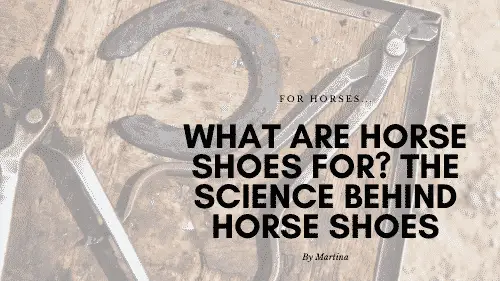Have you ever asked yourself: what are horseshoes for? There have been many debates as to why we put shoes on our horses. After all, they never needed them when they were in the wild! In this article, we will explain to you the history and science behind horseshoes.
For hundreds of years, horses have been one of man’s most loyal and reliable companions. In the past, we have relied on these beautiful creatures to take us to where we need to go, sometimes riding them for days on end. These kinds of situations are what led to the invention of horse shoes.
What is a Horse Shoe, Anyway?
A horseshoe is a man-made product, usually made of metal, specially designed to be attached on a horse’s hoof to protect it from wear. It can be either glued or nailed through an insensitive part of the hoof wall.
It is unclear as to who was the inventor of this remarkable product; what is known is that it has been used for hundreds of years.
What Are Horseshoes For?
Similar to us, horses also need protection from the hard, rough concrete roads. Although horses have their hooves, which are much like thicker human nails, they do not function much like they would many years ago.
This is because most horse breeds are now domesticated. This means they are asked to do stuff they normally do not do in the wild.
In addition to that, a great number of domesticated horses are also being kept in areas that have moist conditions. We normally see them walking on soft soil or standing on wet hay while in their stables. As a result, their hooves become soft and even more susceptible to damage.
Applying horseshoes should be a safe and painless process. But there are people who believe that nailing metal horseshoes on the hoof walls is an inhumane act. Thus, nowadays, more and more horse owners are beginning to embrace the idea of letting their horses go shoe-less.
However, deciding on whether you go on this path is also a big choice to make. By going shoe-less, you need to adjust the footing your horse normally stands on, change its diet, and give the hooves regular trims by hiring a professional farrier (an expert who trims and attaches horse shoes).
Why Are Horseshoes Beneficial?
A thing such as a horseshoe would not have lasted for hundreds—if not thousands—of years if it wasn’t important. From walking on green pastures to hard concrete roads, horses definitely need protection in order to keep their hooves from getting damaged. Other reasons why horseshoes are beneficial include:
Prevents Wear and Tear
Horses that are expected to perform domestic field work such as carrying loads of baggage or pulling weight definitely need protection. Metal shoes are necessary for these kinds of horses so as to keep their hooves from being worn out.
For Overall Health
Sometimes, racing horses suffer from having weak leg muscles or hooves. In order to solve this problem, they are given horseshoes.
These shoes provide them with extra traction when walking on slippery, icy roads and snow. Additionally, it also reduces the excessive stress put on the legs, joints, and hooves.
However, it is very important that these shoes are installed correctly in order to ensure the health of your horse. There are various types of shoes that are used for different occasions and activities. These include heel calks, sliding plates, screw-in shoes, and toe-grabs.
It would be best to refer to the advice of a professional to know which one is right for your horse.

Corrects Bone and Musculature Problems
Through proper therapeutic shoeing performed by experienced and well-trained professionals, horses who suffer from problems in their bones or muscles have a chance to get better. These problems commonly occur in domesticated horses.
Problems with Going Barefoot
Some horses can actually go barefoot. It all depends on their workload. For most pleasure horses, or those that are not regularly ridden, shoes may not be that important.
In contrast, racing or farming horses definitely need them because of the stress that their leg muscles and joints go through every single day.
Below, you will find some of the most common problems that you will possibly face if you ever decide to let your horse go shoe-less.
No Way to Protect Hooves from Ammonia
As mentioned earlier, hooves are similar in composition to human nails. This means that their hooves are mostly made of a compound called keratin.
Prolonged exposure to ammonia, which can be found from urine, causes the hoof wall to soften and become weak.
More Frequent Trims
Similar to our nails, a horse’s hooves also grow, and in order to keep it healthy, the horse would need more frequent grooming from a professional farrier. Moreover, horses are also prone to develop certain diseases and infections when their hooves are not groomed properly.
Conclusion
So, do you still wonder: what are horseshoes for? Do you think horses need it or will their hooves be enough to protect them from the hard pavement and concrete roads? Will you put shoes on your horse or will you go barefoot?
When all’s said and done, it is important to keep in mind that the decision whether to shoe your horse or go unshod is a very big one. The best way to go is to ask the expert advice of both a veterinarian and a professional farrier.
For those horses who have smooth and tough hooves, it may be possible to go barefoot as long as they are groomed frequently and regularly. If you want to learn how to groom your horse, have a read of my guide here.
On the other hand, horses who are expected to handle heavy work or have bone and muscle problems must have shoes to relieve some of the stress or pain from their legs and joints.
Alternatively, you may also opt to give your horse boots. These are similar to human shoes and provide more cushion, better traction, and hoof protection without having to have nails drilled into your horse’s hooves.
Whatever your decision is, we are confident that you will do the right thing, not just for your own benefit, but especially for the comfort of your horse.
Happy riding!
Like this post? Why not pin it!



Great explanation on shoes! I never really gave them a lot of thought. I some what knew the reason for them, but not in such detail.
I hadn’t thought that horses could be used “barefoot” either. Thanks for the education!My niece wants to get a horse so I am going to pass this along. I think your article and site ovearll may help her learn a few things!
Brendon
Hey Brendon,
Thanks for the comment & the recommendation to your niece – I’m always so happy to hear that the content is helpful! If she has any questions she can’t find the answer for or wants to learn more, just let me know.
Cheers,
Martina
I really had no idea the importance of horseshoes before reading this article or what they were really used for. All I knew is growing up in a family that racehorses all the horses had shoes. I never really questioned why.
I can see how they were of great benefit to these types of horses now, especially because they were racehorses.
Now that I live in an area where there are horses ridden on both road and trails I wonder. Should the shoes be changed out if you plan to ride more on road or paved surfaces versus dirt? Is there a difference in the makeup of surfaces that would better protect the horse’s feet?
Thank you,
Christina
Hey Christina,
In terms of protecting their hooves, a lot of it has to do with 1) wear, 2) excessive moisture and 3) also the urea content of the soil they’re in. So if they’re stalls aren’t being cleaned out, the pee can soften their hooves and damage them. Horses should always be kept in clean, dry stalls when they’re inside, so assuming urea and excessive moisture aren’t a problem, then you’re looking at wear.
Think of your nails because horse hooves can be thought of as very thick nails. After you take a long bath, your nails are really fragile and soft, which is why people do their nails wet – their easier to cut and shape that way. Also if you’re doing construction or building something with wood let’s say, you’re likely to ship or crack your nails because of all the wear on them. The same thing applies to horses except to a greater extent.
If a horse has horseshoes, however, the wear doesn’t become that much of a problem because the hooves are protected, it’s kind of like wearing gloves during construction work. Now you won’t get chips or cracks like you would before – I mean as long as the shoes are put on well and you’ve got a good farrier but that’s another issue!
To answer your question about horseshoes, horses that are shod (hooves are shod down and fit with horseshoes) should be seen by the farrier every 4-6 weeks not so much because of the environment that they’re in but because their hooves keep growing so they need to get trimmed down and re-fitted.
Hope this makes sense!
Martina